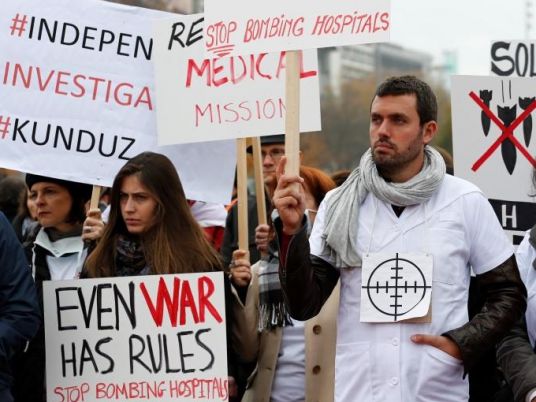
A U.S. investigation found that the deadly Oct. 3 air strike in Afghanistan that destroyed a hospital run by Medecins Sans Frontieres was a tragic and avoidable accident caused primarily by human error, a top U.S. military commander said on Wednesday.
Some U.S. personnel were suspended and could face disciplinary action after failing to follow U.S. rules of engagement in a war zone, said U.S. Army General John Campbell, who leads international forces in Afghanistan.
It remained unclear whether the U.S. military, even as it expressed remorse and wholly accepted blame, would be able to quickly mend its image in Afghanistan and elsewhere after the attack, which killed 30 people.
MSF's general director Christopher Stokes said in a statement on Wednesday that the investigation illustrated "gross negligence" by U.S. forces.
"This was a tragic mistake. U.S. forces would never intentionally strike a hospital or other protected facilities," Campbell said at a Pentagon news conference, releasing the results of the U.S. investigation.
MSF, known as Doctors Without Borders in English, has in the past publicly cast doubt on the idea that the strike could have been a mistake.
Detailing its own investigation on Nov. 5, MSF said the site's location had been clearly communicated to both Afghan forces and the Taliban.
"The frightening catalogue of errors outlined today illustrates gross negligence on the part of U.S. forces and violations of the rules of war," Stokes said in his statement. "MSF reiterates its call for an independent and impartial investigation into the attack on our hospital in Kunduz."
Campbell acknowledged the hospital was on a no-strike list and that MSF had called during the attack to alert the U.S.-led forces. He described a series of mistakes that allowed the American forces to destroy the hospital, despite the call.
According to the U.S. investigation, U.S. forces had meant to target a different building in the city and were led off-track by a technical error in their aircraft's mapping system that initially directed them to an empty field.
The U.S. forces then looked for a target that was visually similar to the one they had originally sought – the former National Directorate of Security headquarters in Kunduz, which they believed was occupied by insurgents.
"Tragically, this misidentification continued throughout the remainder of the operation even though there were contradictory indicators," Campbell said.
The grid location of the AC-130 aircraft that attacked the hospital eventually identified the correct target building. In addition, there was no hostile enemy activity at the MSF building, Campbell said, but the U.S. attack continued.
"These are examples of human and procedural errors," he said.
The timeline detailed by the U.S. military indicated that the 29-minute-long strike began at 2:08 a.m. By 2:20 a.m. a caller from MSF reported the attack to Bagram air base.
It took U.S. forces until 2:37 a.m. to realize the mistake, by which time the AC-130 gunship had already stopped firing.
"It is shocking that an attack can be carried out when U.S. forces have neither eyes on a target nor access to a no-strike list, and have malfunctioning communications systems," MSF's Stokes said.
Campbell said the investigation found that the strike killed 30 staff, patients and assistants and injured 37. He gave his condolences and said the U.S. military would offer to help rebuild the hospital.
"Chaos does not justify this tragedy," Brigadier General Wilson Shoffner, a spokesman, said at the briefing.
"We are absolutely heartbroken over what has occurred here and we will do absolutely everything in our power to make sure that it does not happen again."
